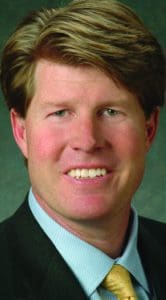 Over the past year, numerous external events — which we refer to as the “big bad wolves” — have huffed and puffed but were unsuccessful in stalling economic activity.
Over the past year, numerous external events — which we refer to as the “big bad wolves” — have huffed and puffed but were unsuccessful in stalling economic activity.
Weather, social divide, military conflict and rising interest rates, all seemingly capable of blowing down economic momentum, had minimal or temporary impacts on actual growth. Clearly the U.S. economy’s fundamentals are solidly grounded on a foundation of brick, rather than straw.
GDP withstands natural disasters
Hurricanes Harvey and Irma hit the United States in August and September. Intuitively and historically we know that material weather events like snow storms and hurricanes cause a temporary negative impact to the labor market and the economy. However, if Katrina in 2005 and Sandy in 2012 are any guides, economic slowdowns will be muted when the rebuilding effort begins.
Second quarter real gross domestic product posted a robust 3.1 percent. The momentum continued into the third quarter with 3.0 percent growth, and we expect fourth quarter GDP to advance well beyond 3.0 percent.
Consumer confidence, labor market unaffected
Charlottesville and the NFL protests, both capable of shaking consumer confidence, also had little impact on the indicators and the stock market. Political uncertainty and social unrest can spook consumers, but confidence remains resilient.
This data is critical since the consumer constitutes 69 percent of the economy. When consumers feel good, they consume. The confidence data remains at close to a 16-year high. This level suggests annualized real consumption growth in the area of 4.0 percent, which supports GDP growth north of 3.0 percent.
A significant driver of consumer confidence is the labor market. Even with all these “big bad wolves” lurking in the economy, labor market conditions are exceptionally tight. Additionally, the number of people who are unemployed per job opening is 1.2 — a ratio we have not seen in 20 years. Furthermore, small firms are reporting difficulties filling open positions, which leads us to believe that the 4.2 percent unemployment rate will continue to fall, and wage inflation will escalate.
Interest rates, Federal Reserve keep it neutral
While interest rates and the Federal Reserve both have “big bad wolf” potential, currently neither appears to be the story’s spoiler. Tighter monetary policy is not slowing economic growth. Even as the Fed expects to continue to modestly raise rates over the next 18 months, strength in the economy is the primary driver.
The President recently nominated Jerome Powell as the new Federal Open Market Committee Chair to succeed Janet Yellen in February. If this nomination is confirmed, we don’t expect any disruption in the Fed’s carefully-laid plan to gently move interest rates higher.
What really matters
Empirical evidence suggests that economic indicators or signals that are focused on economic growth, confidence and profits provide insight into stock market returns, while indicators focused on potential “big bad wolves,” such as policy uncertainty or geopolitical risk provide little, if any, guidance on economic conditions or equity returns.
Presently, political narratives seem to indicate that fiscal stimulus could be an upside risk to our forecast. We do anticipate that some version of tax reform legislation will be completed. This will drive corporate profits higher, support consumer confidence and allow capital expenditures to improve — all supporting favorable GDP growth over the next 12 months.
Forecasting a ‘brick house’ in 2018
Virtually all the economic variables that focus on economic growth, profits and confidence suggest a “brick house” economy. In addition, we are experiencing synchronized global growth. Economic data out of Europe and China, two significant economies, suggest improvement.
Key outlook items include:
- GDP: We expect U.S. GDP growth to be between 2.3 percent and 2.6 percent in 2017. Given the strong readings in numerous economic indicators, we expect economic growth to be between 2.5 percent and 2.8 percent in 2018.
- Stock market: Earnings drive stock prices. Current stock prices are supported by positive earnings growth over the past four quarters. We expect 2018 revenue growth to be up 5 percent and earnings growth to be 10 percent. If there is some form of tax reform, earnings growth could be in the 12 to 15 percent range. Our 2018 year-end S&P 500 target is 2,700.
- Fixed Income: We expect interest rates to drift slowly higher through the end of 2017 and into 2018 as the economy experiences an ongoing period of improvement. Fed funds are expected to reach 1.5 percent, and the 10-year Treasury should rise above 2.5 percent by the end of 2017. We anticipate that fed funds will be close to 2.0 percent, and the 10-year Treasury yield will be around 3.0 percent by the end of 2018.
Conclusion
The huffing and puffing of “big bad wolves” isn’t uncommon in the economic cycle. However, the current data signals a robust economy for at least the next 12 to 18 months. This environment will allow the Fed to raise interest rates on a modest trajectory and it will be positive for both corporate earnings and risk-based assets.
KC Mathews is executive vice president, chief investment officer for UMB Bank, Kansas City, Mo.
